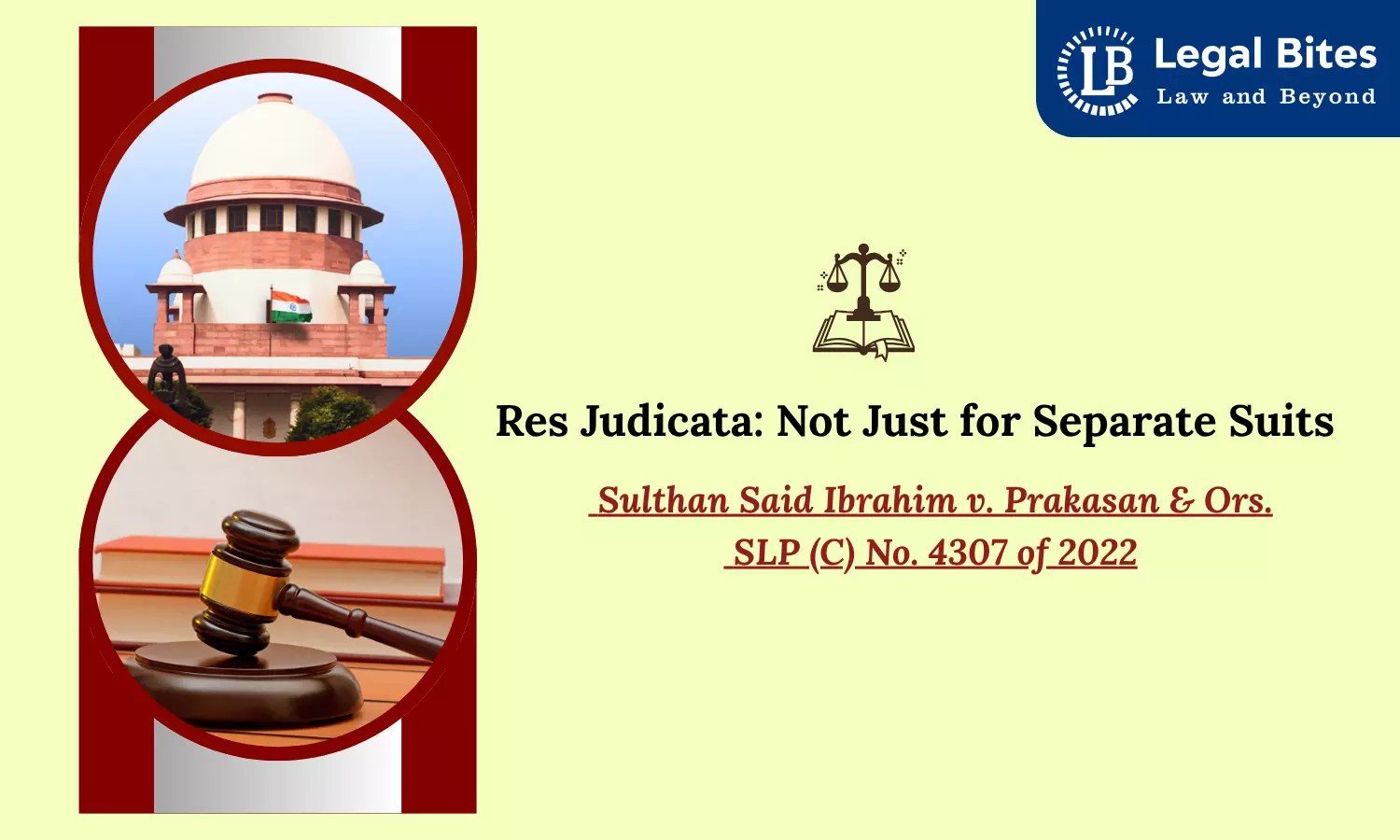Is Res Judicata Limited to Separate Lawsuits, or Can It Operate Within One Suit?
Scroll down to understand how courts apply res judicata to stop procedural abuse, promote timely objections, and ensure finality in judicial proceedings.

This article examines the scope of the doctrine of res judicata in the context of its application within the same legal proceeding. Traditionally understood as a bar on re-litigation between separate suits, the article explores how Indian courts, particularly the Supreme Court, have broadened its applicability to different stages within a single suit. Anchored in the recent 2025 judgment in Sulthan Said Ibrahim v. Prakasan & Ors., (CIVIL APPEAL NO. 7108 OF 2025) the discussion reinforces the doctrine's utility in curbing procedural abuse, ensuring finality, and upholding judicial discipline.
Understanding Res Judicata
The doctrine of res judicata is codified under Section 11 of the Code of Civil Procedure, 1908 (CPC). It bars re-litigation of matters that have been directly and substantially in issue in a prior suit between the same parties, where such matters have been heard and finally decided by a competent court. The objective is twofold: to bring finality to legal disputes and to conserve judicial resources by preventing multiplicity of litigation.
Yet, res judicata is not merely a procedural technicality. It is rooted in public policy and judicial efficiency. Once a court has rendered a decision after full deliberation, it should not be open to any party to question or reopen that issue again, whether in a new suit or even in the same suit at a later stage.
Beyond Separate Proceedings: The Expanded Reach
In India, the judiciary has consistently recognised the application of res judicata within the same proceedings, not just across separate suits. This expanded application—often referred to as "interlocutory res judicata"—serves the same objectives of finality and procedural discipline.
The leading precedent in this regard is Satyadhyan Ghosal v. Deorajin Debi (1960), where the Supreme Court observed that decisions rendered at earlier stages in the same litigation could operate as res judicata at later stages. This judicial approach ensures that parties cannot take contradictory positions or re-agitate issues they have already accepted or lost.
A Contemporary Illustration of Intra-Proceeding Res Judicata
The jurisprudence on this issue was recently reaffirmed in the 2025 Supreme Court decision in Sulthan Said Ibrahim v. Prakasan & Ors.
Background of the Case
The Dispute
The dispute began in 1996 when the original plaintiff filed a suit for specific performance of a sale agreement against Jameela Beevi. The suit property was a one-cent commercial plot in Palakkad, Kerala. An ex parte decree was passed in 1998, later restored for trial, leading to a final decree in 2003. This decree was upheld through appeals up to the Supreme Court.
Multiple Delays
Despite the decree being final, the execution process was plagued with delays. After the death of Jameela Beevi in 2008, her legal heirs were impleaded. One such heir, Sulthan Said Ibrahim (the appellant), was impleaded but later sought deletion of his name from the party array in 2012, claiming he was wrongly added and asserting tenancy rights over the property.
Issue
- Whether the doctrine of res judicata can bar a party from raising objections at a later stage in the same proceedings, especially after having participated without protest at earlier stages?
Supreme Court’s Ruling
The Supreme Court dismissed the appellant’s plea seeking deletion of his name from the array of parties, holding that his application under Order I Rule 10 CPC was barred by the doctrine of res judicata, as he had earlier participated in the proceedings without objection.
The Court emphasised that res judicata applies not only to separate proceedings but also to different stages of the same proceeding, and a party who fails to raise objections at the appropriate stage cannot reopen settled issues later.
Analysis of Findings
1. Failure to Object at the Proper Time
The appellant did not object to his impleadment when notices were served in 2008. He entered an appearance and even participated in various proceedings—including a petition for rescission of contract. It was only in 2012, after multiple adverse findings, that he sought to backtrack.
2. Order I Rule 10 v. Order XXII Rule 4 CPC
The appellant sought deletion under Order I Rule 10(2) CPC. However, the Court clarified:
- Impleadment under Order XXII (upon death of a party) must be contested at that time.
- A belated petition under Order I Rule 10 to escape legal obligations is not maintainable.
3. Constructive Res Judicata
The Court noted that the appellant, by failing to raise objections earlier, was barred under the doctrine of constructive res judicata.
Tenancy Claim: A Delay Tactic?
The appellant claimed tenancy by inheritance, protected under the Kerala Buildings (Lease and Rent Control) Act, 1965. However, the Court rejected this, noting:
- He was a witness to the 1996 sale agreement, which had no mention of tenancy.
- No proof of tenancy between 1996 and 2011 was produced.
- A municipal license in his name (from 2011) was seen as fabricated to frustrate execution.
This reinforced the view that the petition was a strategic move to delay justice.
Key Judicial Precedents Relied Upon
- Satyadhyan Ghosal v. Deorajin Debi, AIR 1960 SC 941: Res judicata applies between different stages of the same suit.
- Bhanu Kumar Jain v. Archana Kumar, (2005) 1 SCC 787: A party cannot reopen an issue conclusively determined at an earlier stage of the same proceeding.
- Babu Lal v. Hazari Lal Kishori Lal, (1982) 1 SCC 525: Specific performance implicitly includes possession when seller holds exclusive possession.
- Ramesh Hirachand Kundanmal v. Municipal Corporation of Bombay, (1992) 2 SCC 524: Discussed power of courts to add or strike parties under Order I Rule 10.
Final Ruling
The Court concluded that:
- The application to delete the appellant’s name was barred by res judicata.
- The claim of tenancy was meritless and raised only to stall execution.
- The possession must now be handed over to the decree-holder within two months, with police aid if required.
- A cost of ₹25,000 was imposed on the appellant, to be paid to the Legal Services Authority.
Key Highlights of the Judgment
The Bench comprising Justice J.B. Pardiwala and Justice R. Mahadevan observed:
"In the present case, the order for impleadment of the appellant as a legal heir was made by the Trial Court after due inquiry under Order XXII, as also observed by the Trial Court in its order rejecting the application under Order I Rule 10. Evidently, neither any objection was raised by the appellant before the Trial Court nor any revision was preferred subsequently against the said order.
Thus, it could be said that the issue as regards the impleadment of the appellant as a legal heir of the original defendant had attained finality between the parties and thus the subsequent application under Order I Rule 10 seeking to get his name deleted from the array of parties could be said to be barred by res judicata.
The Court referenced the case of Y.B. Patil v. Y.L. Patil [(1976) 4 SCC 66], wherein it was held:
"It is well settled that principles of res judicata can be invoked not only in separate subsequent proceedings, they also get attracted in subsequent stage of the same proceedings. Once an order made in the course of a proceeding becomes final, it would be binding at the subsequent stage of that proceeding.”
Conclusion
The Supreme Court in Sulthan Said Ibrahim v. Prakasan & Ors. has laid to rest any doubts about the intra-procedural scope of res judicata. The ruling affirms that parties cannot perpetually delay justice by re-agitating settled issues within the same suit. Once a court of competent jurisdiction has adjudicated a matter conclusively, litigants must accept the finality, regardless of whether they agree with the outcome.
This decision is a reaffirmation of judicial discipline, finality, and the necessity to protect the integrity of court proceedings.

